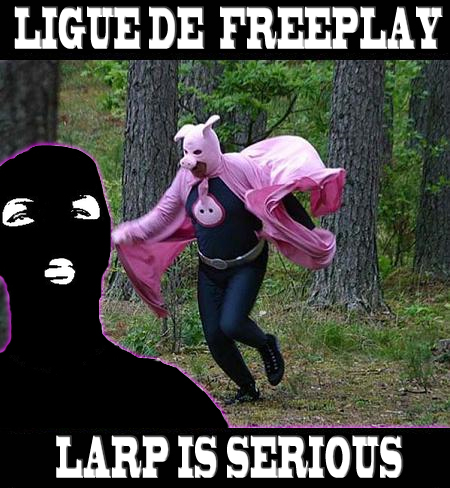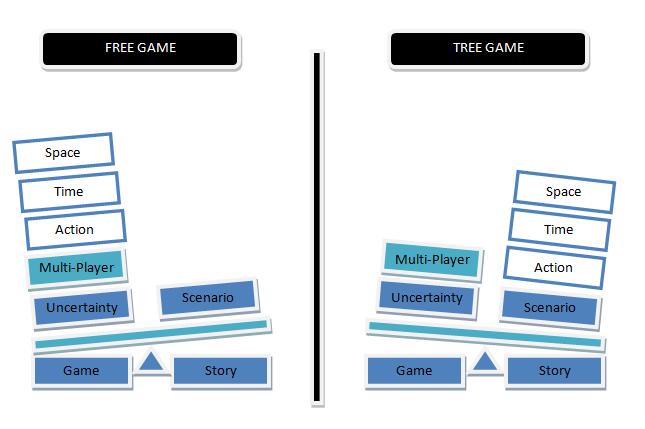Original post: http://www.electro-gn.com/302-jeuetnarration-troisiemepartie
Translation: Vincent Choupaut
We saw the opposition between game and narration, we studied the characteristics of larp which hamper the narrative, and we have now to think about the changes we can do to improve the narrative part of a larp. For that purpose, let us come back to the debate on tension between game and story in larp.
About linearity of story
The stories we like to live at Movie Theater or through literature are linear and definite. But if a story wants to become a game, and in this case a larp, it has necessarily to move away from this linearity. But if you want the game to tell a good story, you have to limit the freedom of the player. Anyway, we are always in logic of compromise between the requirements of a story and those of a game.
We might consider that things are good as they are. If we want a game, we have to increase player’s freedom. The larp, as a specific media, tells stories its own way, with its own management of time, space and action. And if it implies to tell stories otherwise than usual narrative canons, too bad! Bye bye Hollywood. It is clear that if we want to organize such games, the narrative theory is not a great help.
This position is absolutely respectable. But if we admit that larp must work with these conventions, we have to admit the risks it involves. I listed some of these risks in the previous part of this article, and the list could be longer. Playing that way, we expose ourselves to attend some really good scenes during the game, but also disastrous scenes. And these magical moments which make our best games (the right meeting, with the right person, at the right time, which allows to advance the plot, and all of this in the direction of the global story)… these magical moments, I said, should not be left to chance.
About the end of free game
We might also want that larps tell stories stronger and more significant, and remain nevertheless games. This is my point: This freedom, or more precisely this free game which seems to be a principle of several larps is, as I just said, double-edged. A game needs a frame, and if the frame is too flexible, it may create many troubles if we want to live a story. But if you want a larp script to have more consistence and impact, there is no miracle solution, as you might suspect. We have to free ourselves from the conventions of free game, which are the source of what larp can do at its best, but also at its worst. It is about limiting the principles of free game and keeping the player’s freedom at the same time. Without it, larp is actually not a game anymore.
The paradox of many larps is that although they rest mainly on the convention of free game, the organizers are afraid that some things might happen (or on the contrary don’t happen). So they regularly intervene in the game to encourage or prevent players, or even redirect the action. Some events, sometimes even the outcome of the game, take place whatever the players are doing. It might be taken really hard, all the more since the presupposition of larp is a wide enough freedom. It is the usual expression, in a larp, of the tension between game requirements and story requirements.
But what is total freedom in a larp? It means being free to do anything, any time, to play our characters as it suits us (or not play them), without any consideration for organizers and other players. And when we are organizers, to let it go. It is mistaking freedom and laxity.
Why not assume, as an organizer, the will to tell coherent stories. Doing that is not killing the player’s freedom. We can easily free ourselves from the usual rules of time, space and action management, without giving the game up.
The constraints of larp
As in the world of video game, larpers have to come to terms with some constraints, which influence the way to tell stories. Some of these constraints are strong, but other ones may easily be bypassed.
What is the fundamental specificity of larp compared to other close activities, like improvisation theatre or tabletop role playing games? The conjunction of three characteristics:
1) Larp is an interactive fiction in which players interpret physically characters (which distinguish larp from tabletop role playing game)
2) These characters live a story set up by a third party (which distinguish larp from improvisation theatre)
3) These characters may influence the script in a direction or another, according to their choices and actions (which makes larp a game)
However, the lack of strong constraints on time, space and action is not a necessary characteristic of larp, even if this presupposition works on most of the games, because of convention or tradition.
If I admit that I want to tell stories more convincing in larps, that want to help my players to live stronger scenes in stories more consistent, I have to question these conventions.
The uncertainty, I keep it of course: it is essential for the game.
The multiplayer aspect, I keep it too. Not because it is essential. Indeed, the larp which would be the closest to a story is the solo larp, but I want, as anybody, that several players enjoy the story.
So I have to preserve uncertainty and control time, space and action. To have a more structured time and space outline, and let space for the decision of players, I made game archeology, and I exhumed some “monstrous” references. This let me imagine a larp model, which I will present in a future article: Tree LARP.





